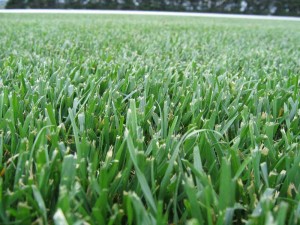Get a life! Let us do your fall turf care. Fall is the most ideal time of year to improve the quality of turf grass and also the best time to tackle some of the  persistent problems hindering the establishment and quality of lawns. Ample soil moisture and cooler temperatures are present during this season and our Midwest grass species love these conditions. The stresses of summer are usually gone by now and lawns can really respond. Listed below are some of the procedures that we use as tools to improve the condition of the lawns that we all love to see and play in.
persistent problems hindering the establishment and quality of lawns. Ample soil moisture and cooler temperatures are present during this season and our Midwest grass species love these conditions. The stresses of summer are usually gone by now and lawns can really respond. Listed below are some of the procedures that we use as tools to improve the condition of the lawns that we all love to see and play in.
Core Aeration
This is a procedure that uses a powered machine to punch through grass, penetrate the soil, and pull up plugs of soil about the size of a bloated French fry. The plugs are made of soil, thatch, roots, and living grass blades and end up on the surface of the lawn. This also leaves holes in the lawn that allow air, moisture, and fertilizer to reach the root zone of the lawn. The benefits include alleviation of soil compaction, air exchange in the root zone, surface drainage, and decomposition of turf thatch. Microbes in the plugs help create a healthy lawn, so, the plugs are left on the surface to eventually decompose.
Seeding
Generally speaking, seeding is best accomplished in the fall because temperatures are cooler and weed pressure is less. Seeding can be done by hand or with a slice seeding machine. Seeding by hand requires preparation of the seedbed. Grass seed will not germinate unless it has contact with soil, and, results will be greatly enhanced if the soil is loose. This can be accomplished by using a tool such as the ‘Garden Weasel’ or a roto-tiller. Over-seeding by machine can be done by using a powered slice seeding machine. This machine actually slices through the lawn, makes vertical cuts into the soil, and drops grass seed into the slits. Soil to seed contact is guaranteed if the machine is adjusted properly. Slice seeding by machine is a very efficient way to over-seed. The machine is expensive to purchase, homeowners will most likely not want to purchase one. Machines can be rented or a homeowner can hire out the procedure. Remember, time is running out for successful seeding. The average cut-off date for seeding is Labor Day. If the weather stays mild and an early frost is not experienced, there is still a little time left to plant grass seed. A starter fertilizer, such as 18-24-12, is quite beneficial in establishing new grass.
Broadleaf Weed Control
Now through November is the best time period to control broadleaf weeds in the lawn. Herbicides can penetrate the waxy leaf surface of the weed easily and phytotoxicity problems with the turf plant itself are lessened because the lawn is less stressed at this time. There must be ample moisture in the soil to ensure rapid translocation of the herbicide through the weed plant. Heed this warning: do not apply herbicide to newly seeded lawns until the new grass plants have been established and mowed at least three times. Young grass seedlings can be severely damaged or killed by broadleaf weed herbicides.
Fertilization
Fall is the most ideal time to fertilize a lawn. Grass plants are actively growing and fertilization enhances strong root growth. Strong root growth is essential for the vigor and survivability of turf. If a person is adverse to applying chemicals on the yard but still wants a healthy lawn, the fall fertilization is the one application that should not be overlooked. If a person wants to apply fertilizer only once a year the application should be done in the fall. A common fertilizer with high nitrogen and no phosphorus, such as 32-0-8, is an acceptable formulation.
Tree Leaf Control
The worst thing for a healthy lawn during this time of year would be the failure to remove tree leaves. A mat of wet leaves left on turf throughout the winter will cause turf death. Be sure to keep up with tree leaf removal. The use of standard methods, such as raking and blowing, will be best accomplished on a regular basis. Put the leaves in a compost pile or use as mulch in planting beds or gardens. A popular organic method of leaf removal is the use of mulching lawn mowers that grind up the fallen leaves and deposit them on the soil surface between the blades of grass. This procedure should also be performed on a regular basis. The message is, don’t leave leaves on top of the lawn.
Mowing
Don’t forget to mow the grass! An un-mowed lawn will quickly become wet, matted, and suffer the same fate as a lawn that did not enjoy tree leaf removal. A wet, matted lawn that survives into spring will suffer many disease problems as well. Recommended mowing height for fescue and bluegrass lawns is generally 3½ – 4½”. Keep it tall and weed pressure will be less.
Granted, fall turf care is a rather dry subject. But, if the procedures are followed properly the results will far outweigh the boredom. Just remember, it’s always fun to work outdoors on a nice cool fall day and it’s terrific to watch a healthy lawn spring to life the following year. Disease, insect, and weed pressure will be greatly minimized in a healthy lawn that receives proper fall care.

